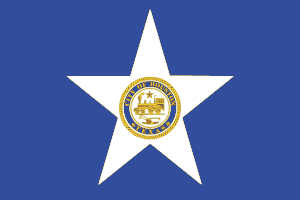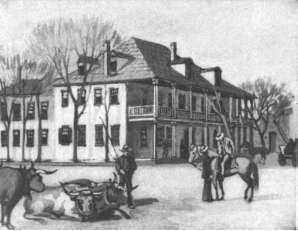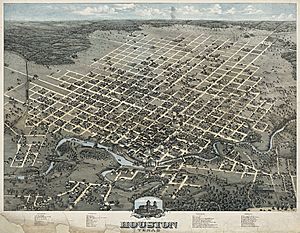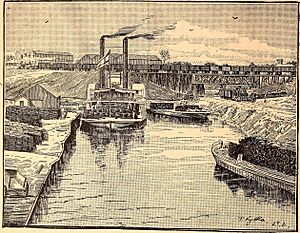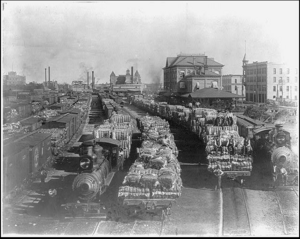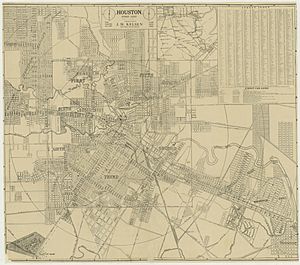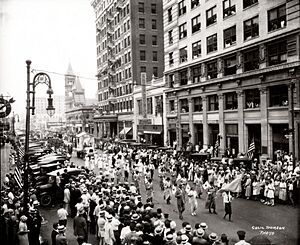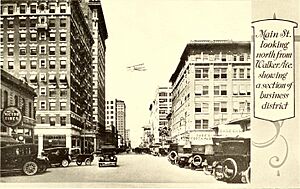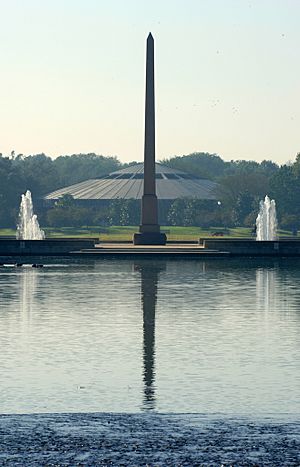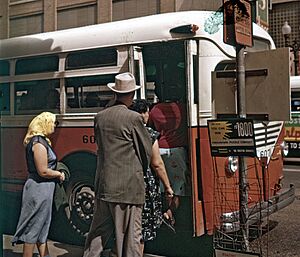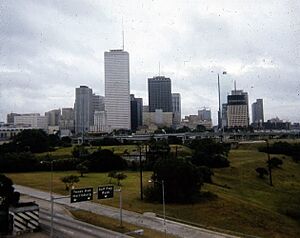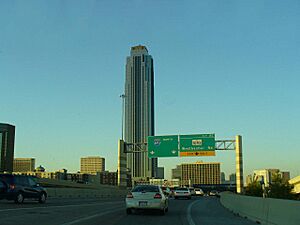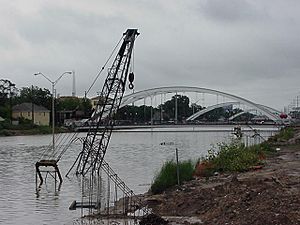History of Houston facts for kids
The city of Houston in Texas, USA, was started in 1837. Two brothers, Augustus and John Allen, bought land in 1836 where Buffalo and White Oak bayous meet. They wanted to build a new town there. Houston was the temporary capital of the Republic of Texas for a while. During this time, it grew into a major center for transportation and business in the region. Houston was part of an independent country until 1846, when the United States officially added Texas.
Railroad building began in the late 1850s but stopped during the American Civil War. Houston helped the Confederacy as a place for military supplies. The city's population grew during the war, and people who smuggled goods past blockades used Houston as a base. After the Civil War, more railroads were built, which created many jobs and improved travel. Houston remained an important business and social center in Texas. It even hosted the first Texas State Fair from 1870 to 1878.
By 1900, Houston's population was over 58,000. That same year, a huge hurricane hit Galveston. Soon after, oil companies opened offices in Houston to manage oil fields in East Texas. In 1912, the Rice Institute (now Rice University) opened, becoming the first college in the area. Many tall buildings were also finished that year. Houston became nationally known when it hosted the 1928 Democratic National Convention in 1928. Around this time, many immigrants from Mexico began to settle in Houston, especially in the Second Ward. The city also developed Hermann Park.
Contents
- Early Beginnings: Before 1836
- Houston as a Capital: 1836–1845
- Early Statehood and Growth: 1845–1861
- Houston During the Civil War: 1861–1865
- After the War: 1866–1900
- A New Era: 1901–1928
- The Great Depression and World War II: 1929–1945
- Modern Houston: 1950s–1960s
- The 1970s and Integration
- The 1980s and 1990s
- Early 21st Century Houston
- See also
Early Beginnings: Before 1836
The area where Houston now stands was once home to the Karankawa and Atakapa native peoples. They lived here for at least 2,000 years before the first known settlers arrived. However, the land was mostly empty until people started settling in the 1830s.
Houston as a Capital: 1836–1845
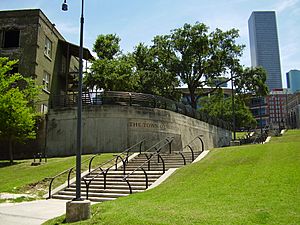


After the Texas Revolution, two land developers, John Kirby Allen and Augustus Chapman Allen, looked for a new town site. They wanted a place connected to the Galveston Bay water system. On August 26, 1836, they bought about 2,214 acres of land for $5,000. Four days later, the Allen brothers advertised their new town, Houston, in a newspaper.
The Allen brothers chose a spot where White Oak Bayou and Buffalo Bayou meet. This place, now called Allen's Landing, was a natural turning spot for boats. In January 1837, the Laura, the first steamship, arrived in Houston. At that time, the town had only twelve residents and one log cabin. Four months later, there were 1,500 people and 100 houses. The Allen brothers promoted Houston as a great shipping center. They said it was at the "head of navigation" on Buffalo Bayou. To prove this, they paid a larger ship, the 262-ton Constitution, to sail to Houston. The ship made it, showing that large vessels could reach the city.
In May 1837, the Texas Congress met in Houston for the first time. Houston officially became a city on June 5, 1837. Later, in 1840, the Chamber of Commerce was formed to help the city's businesses. This was important because Houston faced financial problems and outbreaks of yellow fever, which caused many deaths. Also, the capital of Texas moved from Houston to Austin in 1839.
The city was first governed by a mayor and eight elected officials. In 1839 and 1840, the city was divided into four wards. Each ward elected two officials. While these wards are no longer political divisions, some of their names are still used today.
When Mexico threatened Texas again, President Sam Houston moved the capital back to Houston on June 27, 1842. However, Austin residents wanted to keep important government papers in their city. This led to a disagreement known as the Archive Wars. The capital then moved to Washington on-the-Brazos before returning to Austin in 1845, just before Texas became a U.S. state.
Early Statehood and Growth: 1845–1861

In the years after Texas joined the U.S., Houston saw the rise of important business leaders. These leaders often mixed their business activities with social connections. For example, Thomas W. House started as a junior partner in a business and later married his partner's daughter. He grew his businesses from a bakery to cotton, banking, and real estate. He also invested in transportation like railroads. House helped start the Shearn Methodist Church and Houston's first volunteer fire company.
In the 1850s, Houston still felt a bit like a frontier town. There were more men than women, and many saloons and gambling places. Violence was also common. About one in three Houstonians were born in other countries, often from German-speaking areas. More than one in five people in Houston were enslaved. Enslaved people did hard labor, like construction, moving goods at the docks, or working as servants. By 1860, Houston's population reached 4,428.
Railroads began to spread out from Houston in the 1850s. The first railroad in Texas, the Buffalo Bayou, Brazos and Colorado Railway, started service in 1853, connecting to Harrisburg, a rival town. Houston got access to this railway in 1856. Construction on a railroad based in Houston, later called the Houston and Texas Central Railway, began in 1853. By the start of the Civil War, this railroad reached Millican. Other railroads also opened, connecting Houston to sugar plantations and to Galveston.
Houston During the Civil War: 1861–1865
In 1860, most people in Houston supported the Southern Democratic candidate for president. When the American Civil War began, Harris County voted strongly to leave the Union. The Chamber of Commerce helped keep the city organized during the war.
Houston became an important center for the Confederacy. It served as a military supply hub and the main office for a wartime district that included Texas, New Mexico, and Arizona. Many people from Louisiana and Galveston moved to Houston, almost doubling its population during the war. Because the city was not directly attacked, it was more successful than many other Southern communities. Even though some merchants left, new ones from New Orleans and Galveston took their place. Blockade runners sometimes used Houston as a port, bringing in foreign goods. Despite Union blockades, basic goods like sugar, coffee, and clothing were sometimes available, though there were often shortages and high prices.
After the War: 1866–1900
Reconstruction and Growth
After the Civil War ended and slavery was abolished, many formerly enslaved people moved from the countryside into Houston. The city's Black residents formed groups to help these newcomers find homes and jobs. However, many lived in abandoned buildings or temporary shelters at first.
Houston added the Fifth Ward in 1866 and the Sixth Ward in 1877. Each ward had two elected officials. In 1869, the Ship Channel Company was created to make Buffalo Bayou deeper and improve Houston as a shipping port. Despite social unrest after the war, many people moved to Texas for new opportunities. Businessmen worked to expand the railroad network, which helped Houston become a leading city in the state.
After Texas rejoined the United States in 1870, Houston continued to grow. It became an official port of entry on July 16, 1870. Many African Americans opened businesses and worked for wages. The Freedmen's Bureau helped protect their contracts. White lawmakers insisted on separate schools for Black and white children. Later, in the late 1800s and early 1900s, new laws were passed that made it harder for most African Americans to vote. Jim Crow laws also created and enforced legal segregation across the state.
Houston hosted the first Texas State Fair in 1870. It was held on a temporary site north of Buffalo Bayou. Later, a permanent fairground was bought in an area now known as "Midtown." New streetcar services helped visitors travel between the fair and central Houston. The last state fair in Houston was in 1878.
The Gilded Age in Houston
Houston's population continued to grow quickly after the 1860s. Many Americans moved to Houston looking for jobs. From 1870 to 1900, the city's population grew by large amounts each decade. The number of foreign-born residents decreased, but the percentage of African-American residents stayed steady.
The Houston City Street Railway Company began operating animal-powered streetcars in 1874. Early attempts at streetcar service had failed, but this company succeeded. They built lines in the business district and to the Fairgrounds. New neighborhoods were developed near the Fairgrounds, and developers used the streetcar lines to promote these areas. By 1891, electric streetcars began to replace the mule-driven ones.
Lumber became a major export from Houston's port, while goods for sale were the main imports. The Houston Post newspaper started in 1880, followed by the Houston Chronicle in 1887. Also in 1887, the Sisters of Charity of the Incarnate Word founded a hospital that would become St. Joseph Hospital.
By 1890, Houston had 210 factories employing over 3,000 people. These included metalworking shops, woodworkers, and printers. Over 1,100 workers were employed by Houston's railroads. By 1893, ten different railroads operated in Houston.
A New Era: 1901–1928
On September 8, 1900, the Galveston Hurricane of 1900 caused terrible damage in Galveston. Houston mainly suffered property damage from strong winds and rain, though one death was reported. Houston quickly sent fresh water, food, and medical supplies to Galveston. Many survivors from Galveston came to Houston for temporary shelter. The 1900 census showed 58,203 people living in Houston. A year later, oil was discovered at Spindletop, and Houston became a major center for the oil industry.
Around 1910, many Mexican immigrants settled in the "Segundo Barrio" (Second Ward). They found industrial jobs, especially with railroads. Organizations like the Rusk Settlement House helped the growing Mexican community. The Mexican Revolution that same year led to even more immigration from Mexico to Houston, creating a strong Mexican-American community.
In 1912, Joseph Jay Pastoriza introduced a property tax reform in Houston. This plan aimed to shift the tax burden from personal property and developed land to undeveloped land. It lasted a few years until courts ruled it illegal in 1915. Pastoriza continued to serve as Tax Commissioner and later became the first Mayor of Houston of Hispanic heritage in 1917, though he died shortly after.
Also in 1912, Houston got its first college, the Rice Institute, now Rice University. It opened with a large amount of money to support it. The school hired Edgar Odell Lovett as its first president, who brought in important professors like Julian Huxley.
By 1912, Houston had twenty-five "tall buildings," ranging from six to sixteen stories. The sixteen-story Carter Building was the tallest. There were also two main passenger train stations and several residential buildings. The Rice Hotel was under construction.
In early 1917, the U.S. War Department ordered two military bases to be built in Harris County: Camp Logan and Ellington Field. A battalion of African-American soldiers, the 24th Infantry Regiment, was sent to guard the Camp Logan construction site. However, these soldiers faced hostile treatment in the racially segregated city. This tension led to a riot in August 1917, known as the Camp Logan Riot. Fifteen white people and four Black soldiers died, and many more were injured.
During the 1920s, Houston developed Hermann Park on land donated by George H. Hermann. The Houston Zoological Garden opened in the park in 1924. The park also grew to include a Museum of Natural History and a golf course.
Houston hosted the 1928 Democratic National Convention. The city spent $100,000 to build a new convention hall, Sam Houston Hall, which was completed in just four months. The city also spent money on making public buildings and parks more beautiful. Many new hotels were built to house the expected 25,000 visitors.
The Great Depression and World War II: 1929–1945
In May 1929, a flood caused millions of dollars in damage to Houston property. Houston's population was 292,352 in 1930. Even with the stock market crash, Houston continued to build. Several skyscrapers were completed in 1930. However, unemployment was high. The city continued to modernize downtown, and the Houston Ship Channel became dominated by petroleum, not cotton. Air travel also expanded with new passenger service from Houston to Atlanta. Despite some economic activity, the Depression was evident, with major downtown buildings being auctioned off. In December 1935, floods again struck the city, causing over $1 million in damage and killing several people.
Jesse H. Jones, a local banker, led a group in 1931 to combine their money to help weaker banks. Federal funding from programs like the Reconstruction Finance Corporation and the Works Progress Administration helped build major projects in the mid-1930s. These included a new Houston City Hall and Lamar High School. Houston International Airport also expanded its facilities during the 1930s.
When World War II began, shipping at the port decreased. In April 1940, buses replaced streetcar service. Robertson Stadium was built from 1941 to 1942. Pan Am also started air service that year. World War II led to the reopening of Ellington Field. The U.S. Navy cruiser Houston was named after the city. It sank in 1942 after a battle. In August 1942, a new City Manager government was put in place. The M. D. Anderson Foundation created the Texas Medical Center in 1945. That same year, the University of Houston became a private university, separate from the public school system. Aircraft and shipbuilding grew into large industries in Texas because of the war.
After the war ended, shipping levels at the port rose again in 1946. That same year, E. W. Bertner donated land for the Texas Medical Center. Suburban areas around Houston began to develop from 1946 to 1950. In 1947, Foley's department store opened, and the Alley Theatre had its first performance. Also in 1947, voters rejected a plan for citywide land-use districts, or zoning. Houston began a large effort to annex surrounding areas and increase its size. When air conditioning became common, Houston was called the "World's Most Air Conditioned City."
Modern Houston: 1950s–1960s
The Texas Medical Center began operating in the 1950s. New projects like the Galveston Freeway and the International Terminal at Houston International Airport (now Hobby Airport) showed the area's growing wealth. Millions of dollars were spent on improving old infrastructure. In 1951, the Texas Children's Hospital and the Shriner's Hospital were built. Houston also faced the challenge of needing a new water supply, as relying on groundwater caused the land to sink. Hattie Mae White was elected to the school board in 1959, becoming the first African-American elected to a major position in Houston in the 20th Century.
In 1960, Houston International Airport was no longer big enough. A new airport, Houston Intercontinental Airport (now George Bush Intercontinental Airport), was built north of the city. In September 1961, Hurricane Carla, a very powerful hurricane, hit Houston. On July 4, 1962, NASA opened the Manned Spacecraft Center in southeast Houston, now called the Lyndon B. Johnson Space Center. This brought many jobs to the Houston area. Also in 1962, Houston voters again rejected a plan to implement zoning. In 1963, the University of Houston became a state university after a long effort.
In April 1965, the Astrodome opened. In July 1965, the Houston metropolitan area expanded to include several nearby counties. AstroWorld, a theme park next to the Astrodome, opened in 1968. Houston Intercontinental Airport was completed in 1969. On July 20, 1969, "Houston" was the first word spoken on the moon by American astronaut Neil Armstrong. Houston International Airport, renamed Hobby Airport, closed to commercial flights until 1971.
Barbara Jordan was elected to the U.S. House of Representatives by Houston residents on November 8, 1966.
The 1970s and Integration
In the 1970s, Houston's Chinese American community, which had been small, began to grow quickly.
The Sharpstown scandal, involving government bribes and a real estate developer, happened in 1970 and 1971. One Shell Plaza and Two Shell Plaza were finished in 1971. One Shell Plaza was the tallest building west of the Mississippi River.
The Houston Independent School District was slow to desegregate public schools. In 1970, federal officials forced the district to adopt new rules to end segregation. This was 16 years after the Supreme Court ruled in Brown v. Board of Education that segregated schools were unfair. Racial tensions continued over school integration. Some Hispanic Americans felt they were being treated unfairly by the desegregation plan. They protested by taking their children out of schools until their demands were met in 1973.
The Third Ward became a central area for the African American community. By 1979, African Americans were elected to the city council for the first time since the Reconstruction era.
Water pollution in the Houston Ship Channel became a major concern in 1972. Construction on the Texas Commerce Tower, now the JPMorgan Chase Tower, began in 1979.
The late 1970s saw a population boom in Houston due to the Arab Oil Embargo. Many people from the "Rust Belt" states moved to Houston, often at a rate of over 1,000 a week.
Changes also came to higher education. The Houston Community College system was created in 1972. In 1977, the University of Houston System was established, governing four universities. In 1976, Howard Hughes, once the world's richest man, died on a jet heading to Houston.
The 1980s and 1990s
In 1981, Kathryn J. Whitmire became Houston's first female mayor. She served for 10 years. After she left office, rules were put in place to limit future mayors to serving no more than 6 years. Several new buildings were constructed downtown, including The Park Shopping Mall and the Allied Bank Tower. The Transco Tower, which was the tallest building in the world outside of a central business district, was completed in 1983.
METRO wanted to build a rail system, but voters rejected the plan in 1983. However, voters did approve plans for the George R. Brown Convention Center. In August 1983, Hurricane Alicia hit Galveston and Houston, causing $2 billion in damage.
Houston's large population growth slowed down when oil prices fell in 1986. This led to several years of economic slowdown for the city. The space industry also faced challenges that year with the Challenger disaster in Florida. In 1987, several cultural centers opened, including the George R. Brown Convention Center and the Menil Collection. On August 7, 1988, Congressman Mickey Leland died in a plane crash. On October 3, a Phillips 66 plant exploded in nearby Pasadena, killing 23 people. The Houston Zoo began charging admission fees for the first time in 1988.
In 1990, Houston Intercontinental Airport opened its new Mickey Leland International Airlines terminal, named after the late congressman. In 1991, Sakowitz stores, which had been in Houston since 1911, closed down. In August 1991, city council districts were redrawn to better represent minority groups. In 1993, the G8 group of world leaders visited Houston. Voters rejected zoning for a third time in November.
The planned community of Kingwood was officially added to Houston in 1996. This angered many residents who felt it was forced. The annexation meant Kingwood received Houston's fire and police services.
Rod Paige became superintendent of the Houston Independent School District in 1994. During his seven years, the district became known for high test scores. In 2001, Paige was asked to become U.S. Secretary of Education for the new George W. Bush administration. Lee P. Brown, Houston's first African-American mayor, was elected in 1997.
Early 21st Century Houston
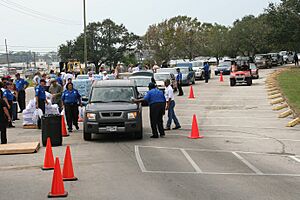
Houston's major sports teams were using old stadiums and threatened to leave. In 1996, the Houston Oilers football team did leave. The city then built Enron Field (now Minute Maid Park) for the Houston Astros baseball team. Reliant Stadium, now NRG Stadium, was built for the new NFL team, the Houston Texans.
Tropical Storm Allison caused severe flooding in June 2001, damaging many neighborhoods and disrupting services at the Texas Medical Center for months. At least 17 people died in the Houston area due to the flooding.
In October 2001, Enron, an energy company based in Houston, was involved in major accounting scandals. This led to the company's collapse and the arrest of several executives.
In 2002, the University of Houston celebrated its 75th anniversary. The University of Houston System also celebrated its 25th anniversary with over 54,000 students.
The new international Terminal E at George Bush Intercontinental Airport opened in 2003 with 30 gates.
The Toyota Center, the arena for the Houston Rockets basketball team, opened in fall 2003.
METRO started light rail service on January 1, 2004. Voters narrowly decided to expand METRO's light rail system.
In 2004, Bill White was the mayor of Houston. The city unveiled the first statue of Mahatma Gandhi in Texas at Hermann Park. In 2010, the Hillcroft and Harwin area, a center for Indian commerce, was renamed the Mahatma Gandhi District.
After Hurricane Katrina in 2005, about 200,000 residents from New Orleans moved to Houston. Soon after, Hurricane Rita, a very strong hurricane, caused 2.5 million Houstonians to evacuate the city. This was the largest urban evacuation in U.S. history.
Six Flags AstroWorld, Houston's only large theme park, closed in 2005.
By 2008, I-10 was being widened to include toll lanes. Also, Discovery Green park was created in downtown Houston.
In January 2010, Annise Parker became the first openly gay mayor of a large American city when she was sworn in as Houston's mayor.
Memorial Day storms in 2015 brought flash flooding to the city, with some areas receiving over 11 inches of rain overnight. At least three people died, and more than 1,000 cars were stranded.
In April 2016, historic flooding hit Houston, killing 5 people.
In August 2017, Houston experienced record flooding from Hurricane Harvey. It caused $125 billion in damage, making it one of the most expensive tropical cyclones in U.S. history.
See also
- Allen Ranch, a large ranch that covered much of modern Houston and helped the city grow
- History of the Mexican-Americans in Houston
- List of mayors of Houston
- Timeline of Houston
- History of African Americans in Houston
|


